- Ribeye vs Sirloin: Our Full Guide - April 7, 2022
- Traeger vs Weber Grills Brand Comparison: Choose The Best! - April 7, 2022
- Ooni Karu Review: Is It Worth It? - April 4, 2022
Everyone has probably heard about the tastiness of ribeye steaks. It may be prime rib roast, rib steak, Texas ribeye, or bone-in ribeye. These are terms used to describe the most flavorful and juiciest cuts of beef. So what is ribeye, how do you choose the best cut, and how do you cook it? Read on to know everything about ribeye.
What is Ribeye?
Just like the name suggests, a ribeye is a cut from the upper rib portion of a cow. Take note the steak has many names that many restaurants, grocery stores, and butchers may use interchangeably.
Rib steak normally means the bone has been left in. In the case of a prime rib roast or a rib roast, several ribs are left together to form a bigger portion of meat. This type of meat is slow-cooked in the oven instead of grilling due to its size.
Why is Bone-in Ribeye Flavorful?
The original location on the cow has a lot to do with its flavor and tenderness. A muscle with low activity has more fat and is less tough. The upper rib area of a cow is where the ribeye steak comes from. This area sees very little in the way of exercise or movement. With this in mind, the ribeye is one of the most tender and well-marbled cuts of beef.
Don’t take this to mean all ribeye steaks are equal. The quality and grade of beef play a major role in determining how flavorful or tender the steak will be. It’s best to look or USDA grade prime beef to ensure you get the most consistent and best cuts that are full of flavor.
Ribeye Steak Buying Guide
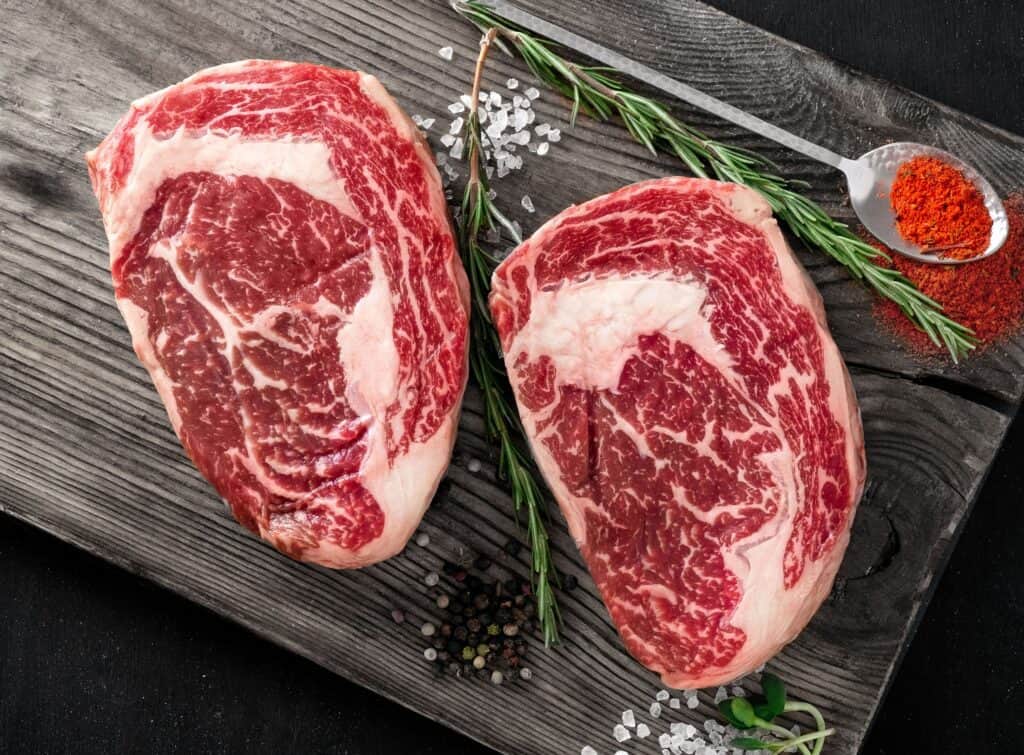
The first thing to look at when buying any steak is its USDA grade. Look for terms such as prime, select, choice, commercial, standard, canner, and cutter. Of these eight grades, look for terms like prime, choice, and select when you purchase your ribeye.
The next step is looking at the flavor profile. Is it grain-fed or grass-fed? Is it grain-fed with grass finish? Also, look at the thickness and size of the steak.
Steaks in the majority of grocery stores are cut very thin. Most chefs prefer steaks that are 1 to 2 inches in thickness. Choose something that you can cook comfortably because the thickness determines whether the steak will be over or undercooked.
Measuring Marbling
The amount of marbling in the steak is a huge factor to consider when buying a ribeye steak. Marbling refers to the amount of intramuscular fat. The cut you choose will determine the amount of marbling in your steak. It also determines the quality of beef you get. USDA in the United States has a beef grading system that’s universal.
The three main categories of prime, choice, and select are determined by marbling. Prime is the highest grade and select is the lowest grade. Keep in mind that despite the low grade of selection, it is the leanest cut of ribeye steak you can get. Unfortunately, it is also the least flavorful. Take these factors into consideration when you purchase a ribeye.
Approximately 40% of all steaks are classified as USDA Select. USDA Choice is the next class up, and it has a higher degree of marbling. Visibly you see large chunks of fat. This may be undesirable as the fat doesn’t melt when you sear or grill the steak.
The choice is the only classification that is sub-categorized into three sub-categories. They are modest, moderate, and small marbling. Small marbling makes up approximately 37% of all steaks.
Modest and moderate marbling makes up approximately 15% and 5% respectively. Prime reigns supreme at the top of the USDA meat grading scale. It has the largest amount of marbling and is the most flavorful choice. Approximately 3% of all steaks are graded prime.
What About Grass-fed Ribeye Steak?

Contrary to popular belief, grass-fed is not a regulated or protected term. It can mean a cow that only ate grass or ate grass at one point. That said, it is crucial to note where your grass-fed beef comes from.
It is also important to understand where your grass-fed beef comes from as well as what breeders are feeding their cattle. Generally, grass-fed beef has less intramuscular fat and is leaner. This is because the grass is not as energy-dense as grain. Additionally, cows that graze get more exercise than their grain-fed counterparts.
Grass-fed beef has gained popularity in recent years. It is touted by many as the healthy choice of ribeye steaks because of its higher Omega-3 fatty acids content.
When you compare the amount of Omega-3 fatty acids in grass-fed ribeye and grain-fed ribeye steaks you find the claim to be true. You get more Omega-3 fatty acids as a consumer when you eat grass-fed ribeye steak.
On the other hand, grain-fed beef has more complex flavors. This means you should consider grass-fed beef if you are looking for a healthy option and grain-fed beef if flavor is your priority.
Some people prefer and enjoy the flavor of grass-fed beef. At the end of the day, it’s a matter of preference. To make a decision, try the same grade of ribeye from grass-fed and grain-fed. This way you will make an informed decision with regards to the type of beef you prefer.
How About Angus Ribeye Steaks?
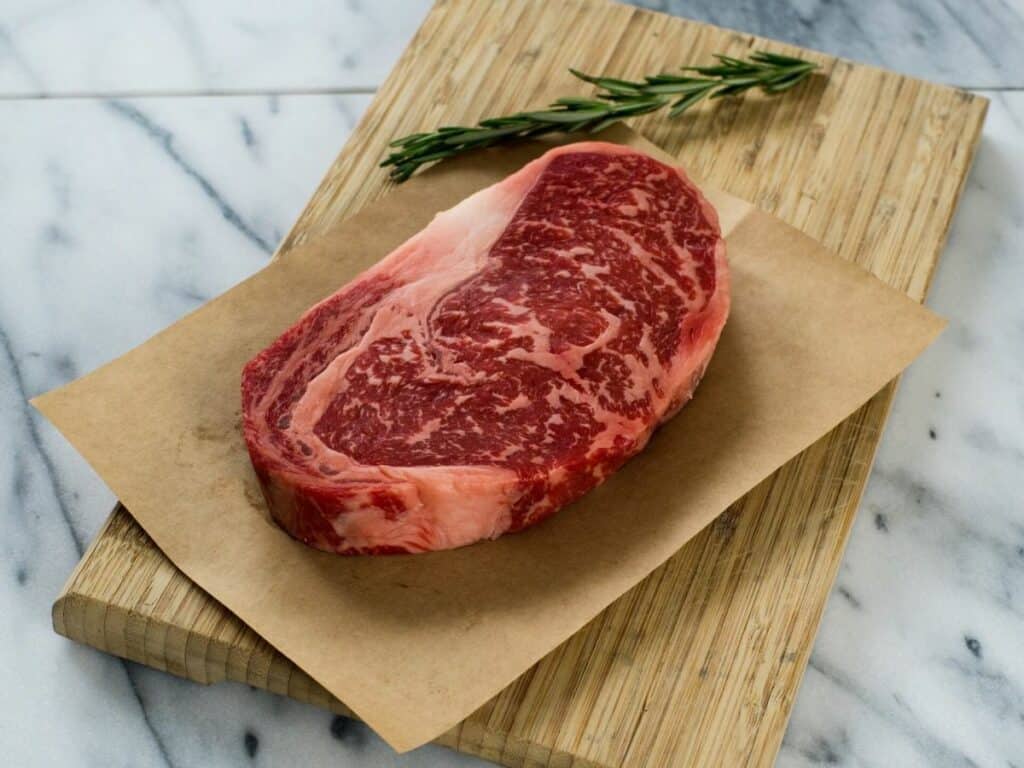
The term certified Angus is common in restaurants and grocery stores. It refers to a specific cattle breed, and not a grade of quality. Aberdeen Angus or Angus is a Scottish breed of cattle that is smaller than your typical American cattle. Since it is not a grading, Angus is graded under the USDA system we mentioned above. The same case applies to non-Angus beef.
Angus is a breed that has been in the United States for some time. In 1883, the American Angus Association was founded in Chicago. Interestingly, it was until 1978 that they came up with the Certified Angus beef standard. The main aim of the standard was to market the idea of high-quality beef.
For a cow to get the certification, it must be 51% black in color. It must also exhibit the Angus influence including cross-breeds and Simmental cattle. Other necessary criteria include a certain hump size, a carcass size under 1,000 pounds, and an above-average marbling.
Japanese Beef Ribeye

Wagyu and Kobe beef are Japanese beef cuts. Kobe is a Japanese black cattle breed. It is mainly one of the Tajima sub-strain. Grain fodder is its food, and it takes a longer period of feeding than U.S. cattle (the U.S. is 18 months Kobe is about 26 – 32 months). This beef also has a higher amount of intramuscular fat. The benefit is it melts like butter when you eat it.
There are approximately 3,000 cattle that annually qualify as Kobe beef. The best cattle are never exported from Japan. Grades of Kobe go from a 5 at the highest end to a lowest of 1.
That said, anything that is imported from Japan is not the real deal. Instead, it may be a crossbreed between the Angus and Tajima strain and other cattle.
Anytime you see the label Kobe beef in the United States know it is not the real deal. Genuine American Kobe beef breeders have their cattle DNA tested before they get certified by the American Wagyu Association.
Keep in mind Kobe beef is so fatty that you need approximately 3 ounces per serving. You will notice it is an entirely different experience from ordinary American ribeye.
If you are keen, you notice it has more of a butter flavor than ordinary steak. As you buy Kobe or Wagyu, keep in mind it is not regulated. You may not get what you want unless you trust the source.
Akaushi Ribeye
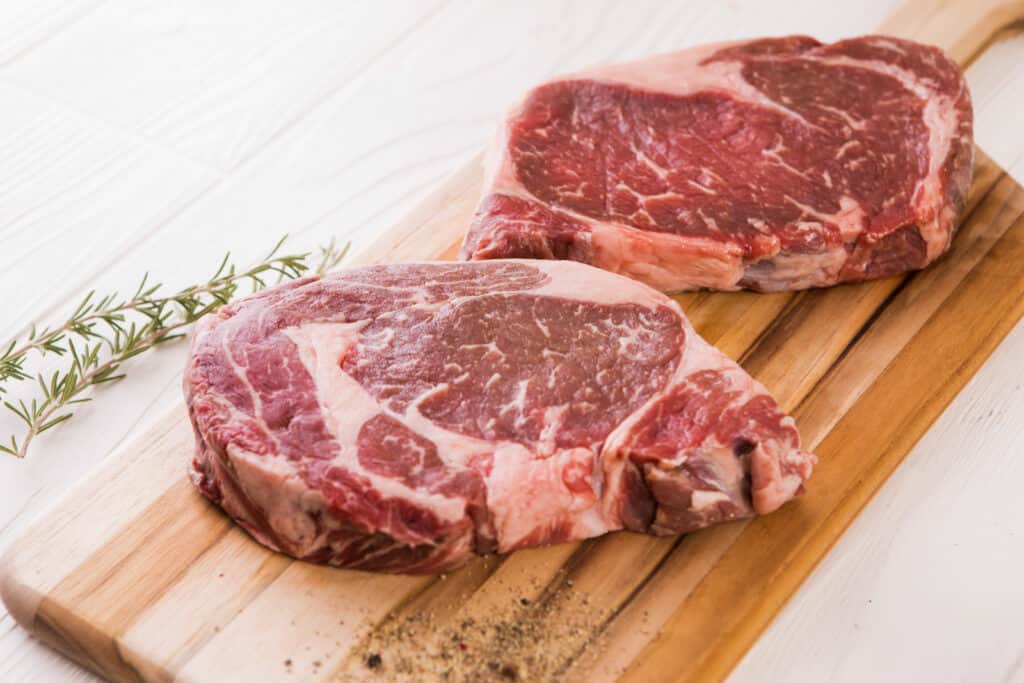
Akaushi is another variety of Japanese beef that has recently gained popularity in the United States. It is a form of brown Japanese cattle. A Texas Ranger, in 1994, imported 11 purebred Akaushi cattle.
He ensured they were separated from American cattle to prevent cross-breeding. In 2020 the ranch had more than 5,000 head of purebred Akaushi cattle. Typically, ribeye steaks from this breed of cattle have more marbling than USDA prime steaks. This means they are usually priced higher.
Where Can I Buy Ribeye?
There are several options to buy high-quality ribeye steaks. They are:
Grocery Store
If you go with this option, know that the lowest-quality steak is pre-cut and shrink-wrapped at the grocery store. You need to understand they may falsify the packaging date. You also risk getting aged beef instead of fresh cuts. Aged beef is okay as long as it has not expired. The best option is getting your ribeye cut at the counter. This way, you get to see the marble of the steak as well as choose the thickness.
Farmer’s Market and Butcher Shop

Your local butcher shop can be a great source of ribeye steaks. Chains of butchers may seem like a good option. The downside is you don’t exactly know where their beef comes from.
An independently owned butcher can tell you exactly where their beef is coming from, why they choose it, and the breed they get. Furthermore, you can have the butcher dry-age your beef according to your preferences. This will give you the flavor you enjoy the most.
A farmer’s market is another great option. One of the benefits is you get to know the farmer well if you purchase meat repeatedly. You can easily learn their preparatory and cattle-raising techniques. You are also guaranteed that the money you spend gets to a farmer instead of a logistics or marketing scheme.
Online Retailers
You can buy any steak including ribeye online. They are usually packed in Styrofoam boxes with dry ice to preserve the steak. Buying online is a suitable option if you don’t want to visit a grocery store, farmer’s market, or butcher shop. Take note the prices of ribeye steak from online retailers are higher than the other options mentioned above.
It is entirely up to you the kind of ribeye steak you choose. Going to the grocery store will ensure you get the lowest overall price. The local farmer’s market or butcher allows you to learn more about the source of your meat.
If you prefer dry-aged ribeye, you have to go to a butcher shop. Dry-aging is not easy to do at home. You need to get someone who has experience with the same.
Additional Tips
The following are tips we recommend when purchasing ribeye steaks:
You can check to see if your steak is tender by using your finger. Push your finger into the meat. If it stays down, it is tender meaning it has been dry-aged properly.
It will remain the same when you grill, broil, or pan-sear it. Normally, grocery store ribeye steaks are not aged for long. As such, they will spring back the moment you remove your finger.
Keep in mind a cow that is slaughtered when it is stressed tastes differently. It also has tougher meat compared to cattle that were slaughtered when it was relaxed. The best course of action is asking the meat seller about their technique.
Consider buying in larger quantities if you are a frequent steak eater. For example, you can buy 5 or more ribeye steaks. Since you can freeze beef and defrost when required, buying in bulk is a cost-effective option for the more carnivorous consumer. Some chefs argue that meat that has been frozen cooks better compared to fresh meat from the refrigerator.
Cooking Your Ribeye Steaks
Now that you have bought the perfect ribeye, it is time to cook it. There are a plethora of cooking methods and recipes you can find online. Some are easy to implement while others are a challenge. The following are three different methods and recipes that guarantee you the best outcome. You can also use the homemade marinade provided below.
Ribeye Steak Marinade
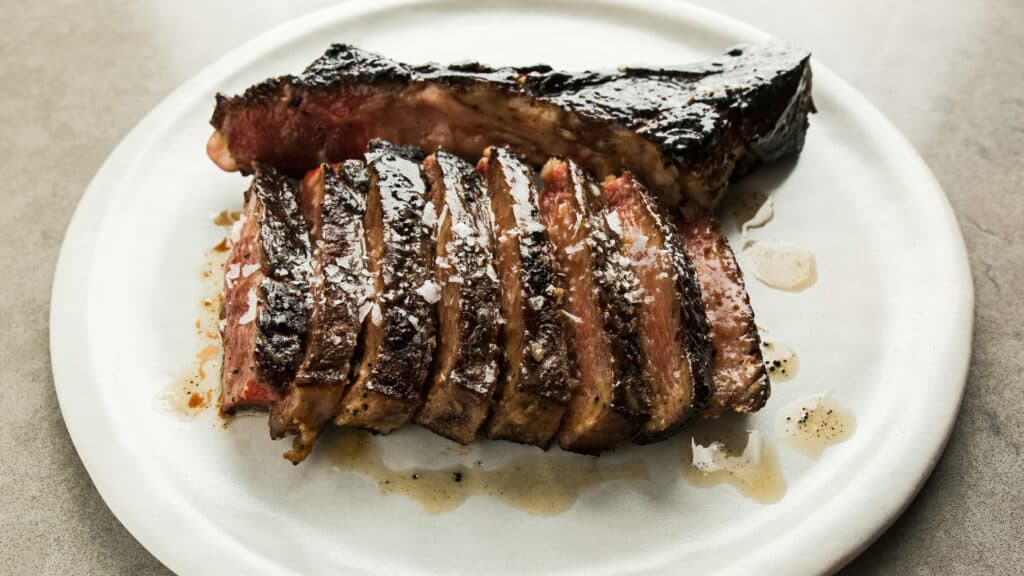
Cooking a steak is one of the best cooking experiences you can enjoy. However, there are some things you need to get before you cook your steak. If you want a marinade, you can easily make one at home. Check out our simple homemade marinade below.
Ingredients
- 1 teaspoon ground white pepper
- 1 ½ tablespoons dried parsley flakes
- 3 tablespoons dried basil
- 1 ½ tablespoon garlic powder
- ¼ cup Worcestershire sauce
- ⅓ cup fresh lemon juice
- ½ cup olive oil
- ⅓ cup soy sauce
- 1 teaspoon dried minced garlic (Optional)
- ¼ teaspoon hot pepper sauce (Optional)
Directions
Step 1:
Place all the above ingredients in a blender. Add the optional garlic and hot pepper sauce if you wish. Set the blender on high and blend for half a minute, or until thoroughly mixed.
Step 2:
Pour marinade on your ribeye steaks. Cover the meat and refrigerate for at least 8 hours. You can now cook your steaks using your preferred method.
Grilled Ribeye Steak
In this recipe, we use homemade steak seasoning made with orange zest and dill. You will also learn how to season your steak perfectly. Check it out!
Seasoning the Steak
Some people believe that a good quality steak doesn’t need to be seasoned. To some level, this may be true. On the other hand, adding salt is crucial even if it is the least you will do.
Salt adds flavor to your meat. It also acts like a sponge by extracting proteins inside the meat to the surface. These proteins are responsible for a wonderfully delicious sear (or crust) on a grilled steak.
The process takes some time. To season your steak properly, apply salt at least 45 minutes before you start cooking. If time is not on your side, add salt right before you cook the steak. This way the salt will at least act as a flavoring agent.
For an extra flavor boost, make a steak rub using fresh spices and herbs. The rub works as a dry marinade and seasoning for the steak. You can make homemade steak seasoning using locally available ingredients.
For example, you can use orange zest and dill mixed with pepper, salt, and onion. It will dance on your tongue giving you a full flavor seasoning mix. The good thing about homemade seasoning is you control the amount of salt you want.
Cooking Times
The times shown below are approximated for a boneless ribeye steak with a 1-inch thickness. Use the chart below to grill our steak to a time and internal temperature that meets your preference.
Always let the meat rest for a while before you serve. During the resting duration, there is an increase of 2 to 3 degrees in the internal temperature. This move is known as carryover cooking.
Internal temperatures for different preferences are as follows:
- Well done – 155° F
- Medium well – 150° F
- Medium – 140° F
- Medium rare – 135° F
- Rare – 131° F
Cooking Bone-in Ribeye
Every time you cook a bone-in ribeye steak, you are guaranteed a better flavor. The reason is the flavor from the bone marrow transfers to the meat. Additionally, the bone gives a more even cooking. This means your chances of overcooking are minimal. However, cooking steaks with bones requires a little more cooking time. Always use a cooking thermometer to make sure your steak reaches the desired temperature.
Steps to Grilling Ribeye
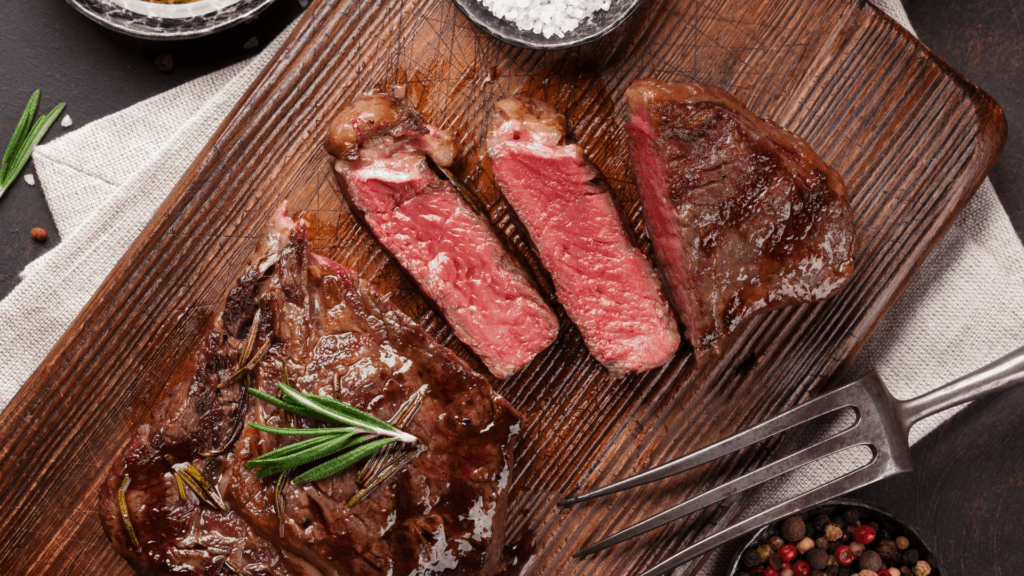
Step 1: Preheat the Grill
The grill must be very hot if you wish to create a delicious golden-brown crust. Ideally, preheat the grill to at least 400° F.
Step 2: Cooking the Steak
Place your seasoned steaks on the hot grill. Cook them on the first side for about 5 minutes. Flip over and continue cooking until they are done to your preference. You can continue flipping and cooking to ensure the steaks are grilled evenly.
Step 3: Topping
When the steaks are ready, do not remove them immediately from the grill. Add a slice of compound butter at the top of each of your steaks. Close the grill cover for at least one minute. The butter will melt into the steak. This will increase the flavor of your ribeye steak.
Step 4: Finishing Up
Remove the steaks from your grill. Let them rest for at least five minutes before you serve. You can serve the steaks with baked potatoes or other options you want.
Tips:
- Buy ribeye steaks with a substantial amount of marbling
- Don’t choose steaks that are too thick. The best option is bone-in steaks or those with anything between one and two inches thickness
- For toppings, use compound butter, blue cheese steak butter, or herb butter. You need to buy these or make them before you start grilling to give it time to chill. If these butter options are not available, use plain butter
- You can experiment with rubs made from basil, fresh cilantro, and other herbs. It’s all up to your tastes and preferences
Broiled Ribeye Steak
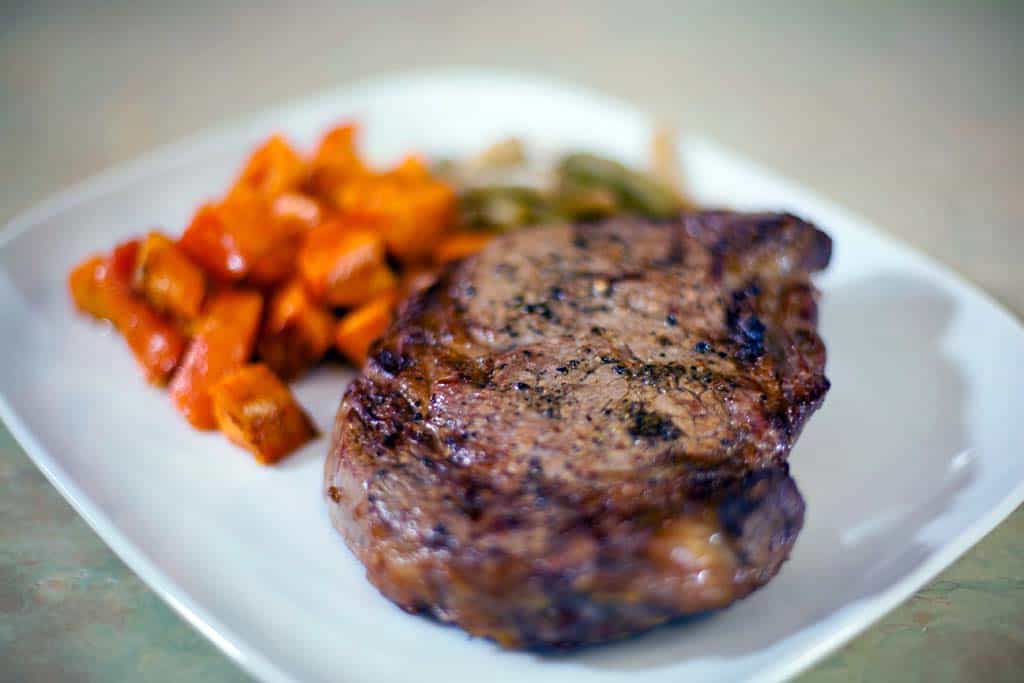
Grilling is a great option for people who know their way around a grill. If you don’t, you can still enjoy your ribeye by broiling it. In this case, we recommend you get thickly cut steaks.
Ideally, anything between 1 ½ to 2-inch steaks will work wonderfully. Thick steaks are great for broiling because they have more time to develop the crust around the steak without overcooking the inside.
Temperature Guide for Broiling Ribeye
When you are broiling ribeye, the internal temperature is different from grilling a steak. A digital cooking thermometer is the best tool to use when you check the internal temperature of your steaks. The temperatures for different broiling doneness are:
- Well done – 160° F or more
- Medium well – 150° F to 160° F
- Medium – 140° F to 150° F
- Medium rare – Approximately 130° F to 140° F
- Rare – 120° F to 125° F
Steps to Broil Ribeye
Step 1: Seasoning
Start by seasoning the steak before you broil it. If the steaks were in your refrigerator, let them reach room temperature before you start seasoning. Since this is tender meat, we will not be using a lot of seasoning.
You just need to use some salt and pepper. Try using high-quality salts such as sea salt or kosher salt. For additional flavor, you can add a freshly cracked pepper.
Step 2: Broiling
Always broil your ribeye one side at a time. Start by heating your broiler to high. Place your oven rack at the second position from the top. This will give the broiler room to evenly spread its heat.
Lay the steaks in the broiling pan in a way they get even and direct heat. After you have heated the broiler for about 5 minutes, you can put the steaks on the broiler.
Step 3: Flipping the Steaks
Flip the steaks to ensure you broil the other side. After 5 minutes in the oven, you should start seeing a nice golden brown exterior. Try to use spring-loaded tongs to flip the steaks.
Continue cooking the steaks until the internal temperature reaches your preferred doneness (check out the temperature guide above). Use a cooking thermometer to check the internal temperature of your steak.
Step 4: Finishing Up
Once the steaks have reached your desired doneness, rest them for about 10 – 15 minutes. Place them on a rack when you remove them from the oven. The more done your steak is the more resting time it will need.
For example, a rare steak may be rested for a couple of minutes. On the other hand, a well-done steak will need to rest for about 15 minutes.
Tips:
- Ribeye steaks with a ring of dark meat around them are the best choice. They will taste the best when you broil them
- Season the steaks with salt and pepper if you want simple preparation with good results
- Broil on high, but make sure you check the internal temperature to prevent overcooking
- The easiest way to monitor the temperature of the steaks as they cook is by using a digital thermometer with a detachable probe
- Rest the steaks on a wire rack. This allows the juices to drip freely as they cool. Internal juices need time to coagulate to prevent the steak from squirting juices when you cut it
Skillet Ribeye Steak
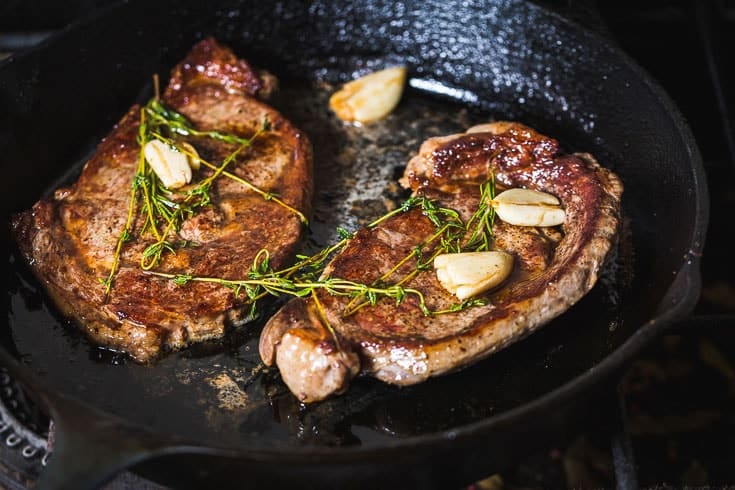
If you don’t want to grill or broil your ribeye, the next option is skillet ribeye. The following is a recipe that is easy to use. If you haven’t pan-fried steak before, this recipe will help you do it right the first time. Now you can start preparing the steaks.
Step 1: Seasoning
The steak is the first thing to consider. Go for 1 ¼ to 1 ½ inch bone-in ribeye steaks if you want to use this recipe successfully. Sprinkle seasoning on both sides of the steak. You can use homemade seasoning or buy seasoning specifically designed for skillet ribeye.
Make sure you pat the seasoning into the meat to ensure it adheres. You can also sprinkle the tops of each steak with freshly chopped rosemary. It isn’t a must, but it will add more flavor to your steak.
For the best results, cover your steaks and let them rest in the fridge for at least an hour before you cook. Ideally, the longer they stay in the fridge the better the result.
We recommend you prep them one evening before you plan on cooking them. When it’s time to cook, allow them to rest for about half an hour at room temperature. If you don’t have the time to let the steaks rest for at least an hour, let them rest at room temperature for about half an hour before you cook.
Step 2: Cooking
Heat the skillet over medium heat when you are ready to cook the ribeye steaks. Add some olive oil and butter to the skillet. You can use common cooking oil without butter.
However, the flavor will not be the same. When you use butter, try and use unsalted butter. The majority of steak seasonings have salt. Using salted butter may increase the amount of salt on your steaks making them too salty.
Add the olive oil first and follow with the butter. Once the butter has melted, tilt the skillet from left to right and vice versa. Your skillet should be well coated with a mixture of olive oil and butter. Carefully add the steaks to your skillet. Place them gently inside to avoid splashing the olive oil and butter mixture.
Cook the steaks until they are caramelized and dark brown on the bottom. This is usually for about 5 minutes. Turn the steaks over to cook the other side for an additional 5 minutes if you want a medium-rare steak. Make sure you are basting the steak with the olive oil and butter mixture as you cook each side.
Step 3: Finishing Up
Remove the steaks from the skillet and place them on a serving platter or carving board. Let them rest for at least 5 minutes. Once rested, carve the steak moving against the grain. Remove it from the bone before you serve.
Usually, a single steak can serve two people depending on how much each individual can eat. The number of steaks you cook is determined by the number and appetite of your guests. Enjoy!
Ribeye Steak FAQs
Answer: You can easily season a ribeye steak using lots of coarsely ground pepper and kosher salt. Season each side well and let the steak rest at room temperature. The resting allows the salt to dissolve into the meat to break it down.
Answer: A lot of connective tissue in the steak makes it tough. It may also be the result of a heavily exercised muscle. Exercises increase the quantity of connective tissue in the muscles thus making them tougher. The best cut is one from a little-used muscle and with little connective tissue.
Answer: Yes, you can! Lay it on a plate and cover both sides with a teaspoon of sea or kosher salt before you cook. Gently work the salt granules into the meat’s surface using your fingers. This helps to break down the fibers of the meat thus tenderizing it.
Answer: 1-inch is a good starting for this kind of steak. When it comes to premium cuts, the best steaks are around 1.5 inches in thickness.
Answer: Salt or season your meat overnight for the best results. Cover each side of your steak with seasoning or salt. Put the steak in your refrigerator and let it sit overnight. By the following evening, the seasoning or salt will have dissolved into the meat.
Conclusion
Ribeye is a great steak as long as you know how to go about buying it and cooking it. With the above information, you should effectively buy the best ribeye steaks. You can also use the recipes to make your steaks using the three methods provided. Follow the instructions provided to cook a steak from start to tantalizing finish!
